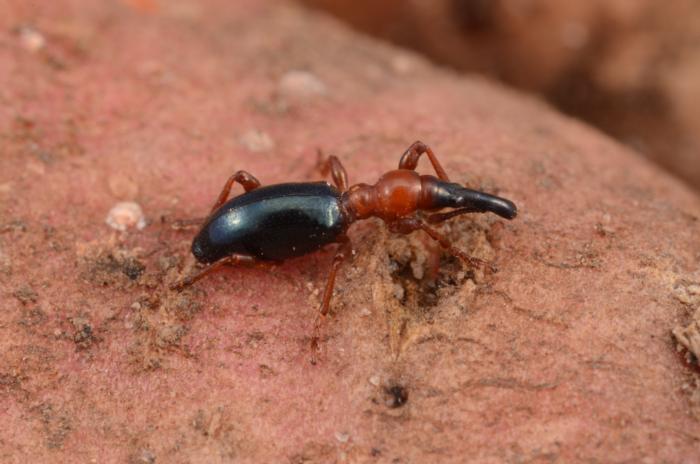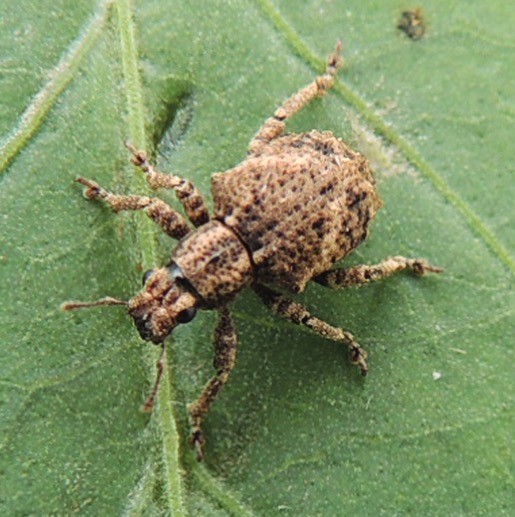INSECT HOT TOPICS: Sweet potato and rough sweet potato weevils
by James A. Bethke
The sweet potato weevil, Cylas formicarius (Fabricius) (fig. 1), is considered an “A”-rated pest by the CDFA and rightfully so. In 2011, California sweet potato (Ipomea batatas) production for processing and fresh market consumption was estimated to be a $130-million industry, with production of about 582 million pounds on 18,200 acres (Reddy and Chi 2015). In an average year, California produces 20% of the sweet potatoes grown in the United States, and it is the second largest producing state behind North Carolina. Sweet potato production in the United States is low, largely due to the sweet potato weevil, and in some states like Louisiana, the distribution of ornamental sweet potatoes into areas where sweet potatoes are commercially grown is regulated by the Louisiana Department of Agriculture and Forestry. Plant damage can be quite significant, and includes adult feeding damage on leaf edges and grub feeding damage to the storage root.

Table 1. Common hosts plants for sweet potato weevil Cylas formicarius (Fabricius). Source: Plantwise Knowledge Bank.
Calystegia sepium (great bindweed)
Colocasia esculenta (taro)
Cuscuta (dodder)
Ipomoea (morning glory)
Ipomoea aquatica (swamp morning glory)
Ipomoea batatas (sweet potato)
Ipomoea cairica (five-fingered morning glory)
Ipomoea pes-caprae (beach morning glory)
Ipomoea purpurea (tall morning glory)
Ipomoea quamoclit (Cupid's-flower)
Jacquemontia tamnifolia (smallflower morning glory)
Pharbitis nil (Japanese morning glory)
The sweet potato weevil is found in southern states from North Carolina to Texas, and in Hawaii and Puerto Rico. Unfortunately, it has often been intercepted by CDFA inspectors, most recently on a shipment of ginger root from Hawaii. This weevil feeds on plants in the plant family Convolvulaceae, and its primary hosts are in the genus Ipomoea (ginger is in the plant family Zingiberaceae and is not a host plant). Suitable wild hosts include railroad vine (Ipomoea pes-caprae) and morning glory (Ipomoea pandurata). See table 1 for a list of common host plants.
A new sweet potato weevil is present in Hawaii and could threaten sweet potato production in California and nursery stock movement. It’s called the rough sweet potato weevil, Blosyrus asellus (Olivier) (fig 2.). It was first detected in Hawaii at a commercial Okinawan sweet potato farm. Its native range includes Southeast and Eastern Asia, Philippines, Japan, Taiwan and China. It is not known to occur on the mainland United States.

At this point, there is no indication of infestations on morning glory plants in Hawaii. Obviously, the rough sweet potato weevil adults can move on infested sweet potato slips (propagative material), but it is possible that grubs could move on potted ornamental sweet potato or on other types of nursery stock (e.g., ornamental plants related to sweet potatoes in the plant family Convolvulaceae or nonhost nursery plants produced near weevil-invested sweet potato fields). It has been documented that the weevils prefer the purple flesh of the “Okinawan” sweet potato (Ipomoea batatas). As with the sweet potato weevil, rough sweet potato weevil adults feed on leaf edges and grubs feed on the storage root.
In the ornamental market, there are numerous, popular Ipomea varieties (Ipomoea batatas), which include everything from groundcovers to tree form. During the 1990s, ornamental sweet potato increased in popularity due to their ease of culture and extensive exposure in gardening magazine articles, and they became widely available in nurseries. Further, new cultivars with new characteristics are making ornamental sweet potatoes more versatile than ever in the landscape. With this increasing market comes the greater chance of invasion of sweet potato weevils into California landscapes and agriculture. Therefore, if you import ornamental sweet potato varieties to finish, please take the time to check and make sure they are free from weevils, especially if they are from sweet potato weevil-infested areas.
James A. Bethke is Farm Advisor for Nurseries and Floriculture, UC Cooperative Extension, San Diego and Riverside Counties.
References
Benedict L, Smith T, Hammond AM. 2008. Managing sweetpotato weevils in South Louisiana. Louisiana State University, College of Agriculture. http://www.lsuagcenter.com/portals/communications/publications/agmag/archive/2008/winter/managing-sweetpotato-weevils-in-south-louisiana.
Brookshire B. 2014. Sweet potato weevils have favorite colors. Science News. https://www.sciencenews.org/blog/scicurious/sweet-potato-weevils-have-favorite-colors.
Capinera JL. 2015. Sweet potato weevil. Featured creatures, University of Florida. http://entnemdept.ufl.edu/creatures/veg/potato/sweetpotato_weevil.htm.
Gill D. 2012. Ornamental sweet potato vine is a vivid garden accent. The Times-Picayune. http://www.nola.com/homegarden/index.ssf/2012/05/ornamental_sweet_potato_vine_i.html.
Heu RA, Tsuda DM, Fukuda SK, Young CL, Lee MI. 2014. A rough sweetpotato weevil, Blosyrus asellus (Olivier)(Coleoptera: Curculionidae). New Pest Advisory. https://hdoa.hawaii.gov/pi/files/2013/01/NPA-Blosyrus-MASTER.pdf.
Plantwise. Sweet potato weevil (Cylas formicarius). Plantwise Knowledge Bank. https://www.plantwise.org/KnowledgeBank/Datasheet.aspx?dsid=17408.
Reddy, GVP, Chi H. 2015. Demographic. comparison of sweetpotato weevil reared on a major host, Ipomoea batatas, and an alternative host, I. triloba. Sci Rep. 2015; 5: 11871. https://www.ncbi.nlm.nih.gov/pmc/articles/PMC4496664/.
Sherman M, Tamashiro M. 1954. The sweetpotato weevils in Hawaii: their biology and control. https://www.ctahr.hawaii.edu/oc/freepubs/pdf/tb-23.pdf.
Stoddard CS, Davis RM, Cantwell M. 2013. Sweetpotato production in California. University of California Vegetable Research and Information Center, Division of Agriculture and Natural Resources, University of California, Vegetable production series, Publication 7237. http://anrcatalog.ucanr.edu/pdf/7237.pdf.












